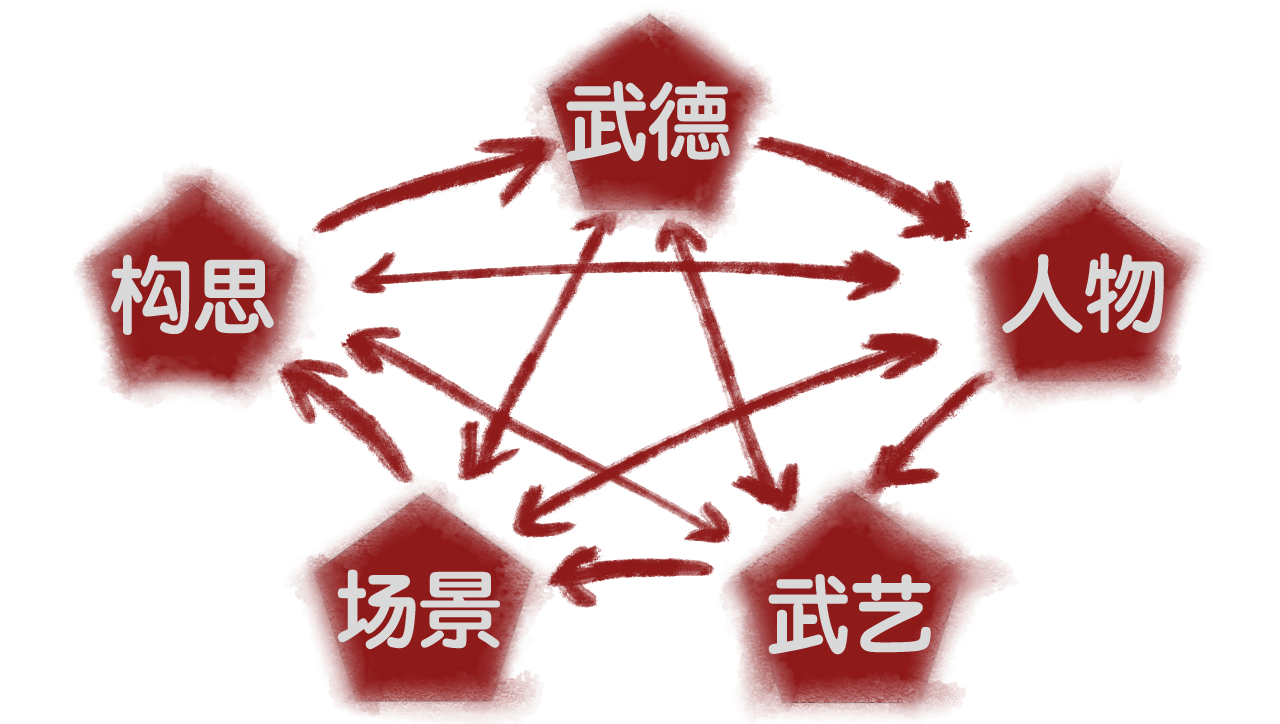Understanding the Heart of Chinese Martial Arts in Storytelling
Wuxia (武侠), meaning “martial heroes,” is a genre of Chinese fiction that blends martial arts, chivalry, and philosophy into epic tales of personal virtue and moral struggle. While it draws from deep historical and cultural roots, wuxia has evolved into a global narrative form—shaping everything from classic literature to modern cinema and animation.
But what defines wuxia? What makes these stories resonate across centuries and cultures?
To explore that, we turn to the Five Elements of Wuxia — our framework for outlining the core characteristics that make these tales timeless.
1. Virtue
Virtue (德 Dé ) – At its foundation, wuxia is guided by a strong moral compass. The heroes in these stories often live by an internal code that prioritizes righteousness, loyalty, courage, compassion, and humility. These values inform every action and decision, serving as the central engine of the narrative.
In wuxia, physical power is meaningless without ethical clarity. True heroism is measured not by strength, but by the moral choices a character makes in difficult situations.
2. Character
Character (人物 Rénwù ) – Character development lies at the emotional core of wuxia. These are not just warriors—they are complex individuals shaped by personal loss, injustice, and internal conflict. Whether noble swordsmen, wandering monks, or reluctant heroes, characters in wuxia grow through hardship and moral confrontation.
Audiences connect with their journeys because they reflect real human dilemmas, elevated through the stylized lens of martial heroism.
3. Conflict Resolution
Conflict Resolution (构思 Gòusī ) – Wuxia narratives weave together intricate personal and external conflicts. These include rival martial arts sects, corrupt officials, hidden bloodlines, and philosophical disputes. However, the true tension often lies within the hero’s conscience—torn between duty, honor, vengeance, and forgiveness.
The most compelling plots are not over-engineered but evolve organically, balancing action with introspection.
4. Setting
Setting (场景 Chǎngjǐng ) – Although often set in a romanticized version of ancient China—frequently during the Ming or Qing dynasties—wuxia’s landscapes are richly imagined and culturally grounded. From mist-shrouded mountains and hidden temples to imperial courts and outlaw hideouts, the setting enhances the genre’s sense of myth and history.
This immersive world, often referred to as jianghu, operates under its own rules and codes, offering a realm where characters can pursue justice and transcend social boundaries.
5. Martial Arts
Martial Arts (武艺 Wǔyì ) – While combat is central to wuxia, it is never gratuitous. Martial arts serve as a metaphor for internal transformation. Every sword technique, pressure-point strike, or qi-based movement reflects the character’s philosophy, discipline, and emotional state.
In well-crafted wuxia, the choreography is not just visual spectacle—it’s a language of its own, revealing growth, intent, and resolution through movement.
Why These Elements Matter
When combined, these five elements elevate wuxia into something more than historical fiction or fantasy. They give the genre emotional depth, ethical nuance, and cultural resonance:
- Virtue grounds the narrative in a strong moral framework.
- Characters provide emotional investment and depth.
- Conflict drives the momentum and complexity of the story.
- Setting creates a tangible, immersive world.
- Martial essence offers a physical and philosophical dimension to the action.
In essence, wuxia is not about violence—it’s about the meaning behind every movement and decision.
In Modern Media
The influence of wuxia extends far beyond Chinese literature and cinema. Its themes and aesthetics have permeated global pop culture in surprising and profound ways:
- Avatar: The Last Airbender adapts the idea of elemental martial arts into a story of balance, duty, and redemption. The bending arts reflect the internal struggles of the characters, much like traditional wuxia.
- Shang-Chi and the Legend of the Ten Rings draws on wuxia’s tropes—family legacies, mystical combat, and the tension between personal freedom and inherited duty.
- Shaolin Cowboy, though surreal and stylized, echoes the wuxia archetype of the wandering warrior, using exaggerated battles to convey existential themes and unspoken moral purpose.
These modern adaptations demonstrate how the genre’s core principles—honor, transformation, and moral courage—continue to resonate across audiences and formats.
The Wuxia Way
For those who love it, Wuxia is far more than a genre for martial arts storytelling. It is a cultural expression of values, identity, and the human search for meaning in a chaotic world. Through its five essential elements— Virtue, Character, Conflict, Setting, and Philosophy —wuxia remains a living art form that inspires both entertainment and reflection.
Whether you’re exploring a classic novel, watching a wuxia film, or discovering its echoes in global media, you’re engaging with a tradition that values the strength of both body and spirit. And that makes it as relevant today as it was centuries ago.
Want to explore more? Start with classic wuxia films, explore graphic novels, or revisit modern series influenced by the genre. What’s your favorite wuxia story? Share your thoughts in the comments below.


Leave a Reply